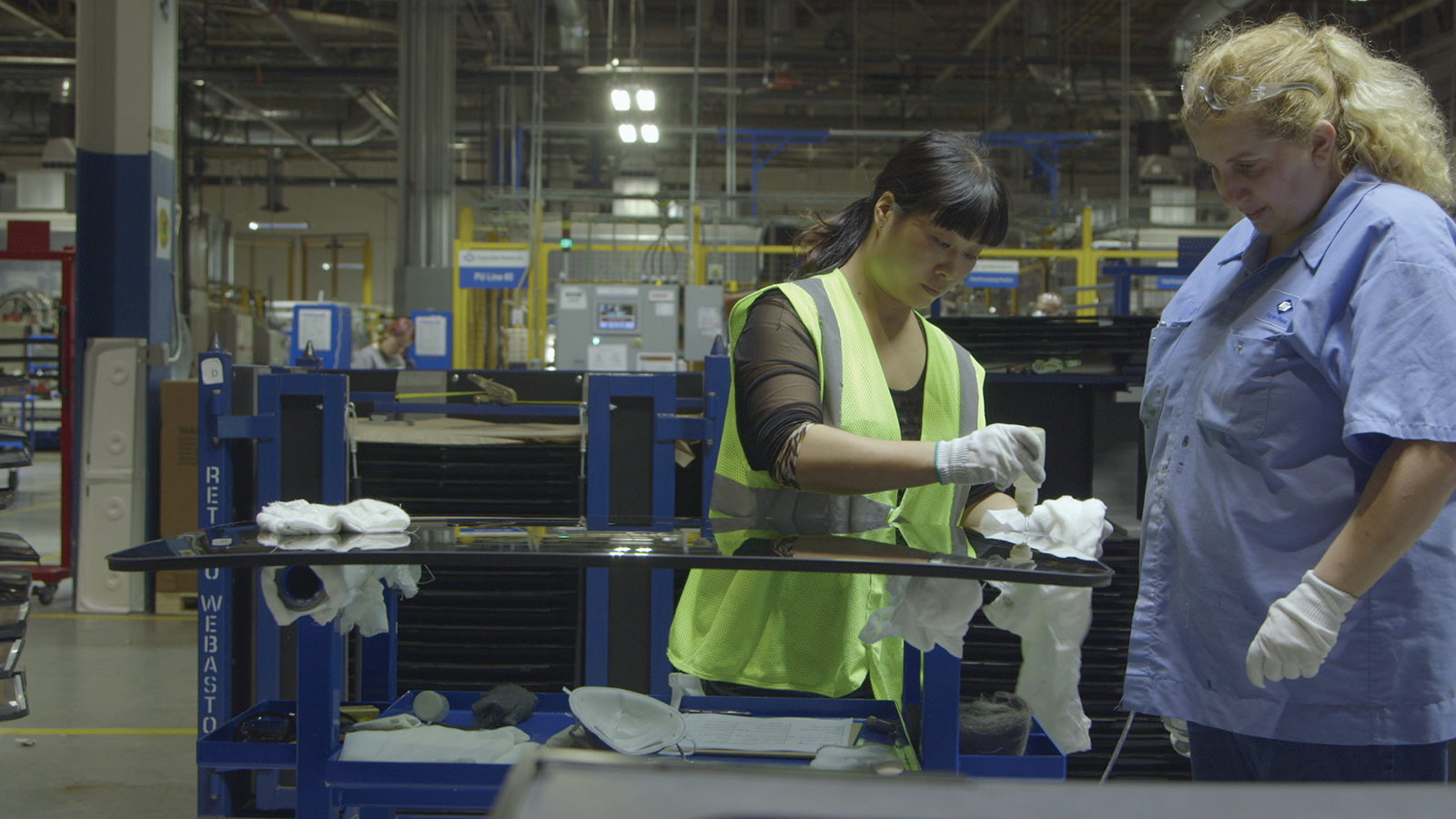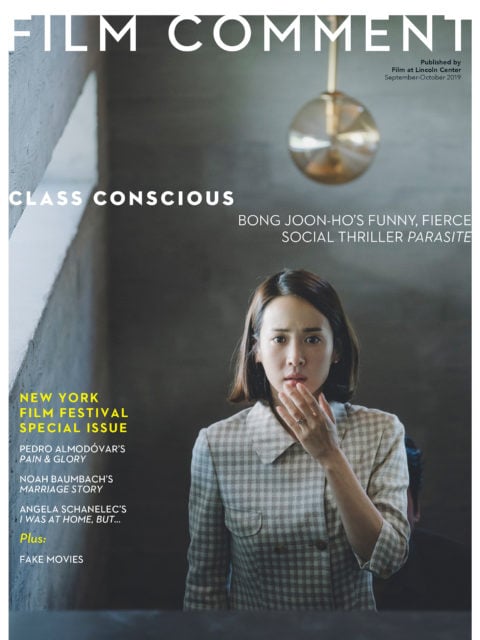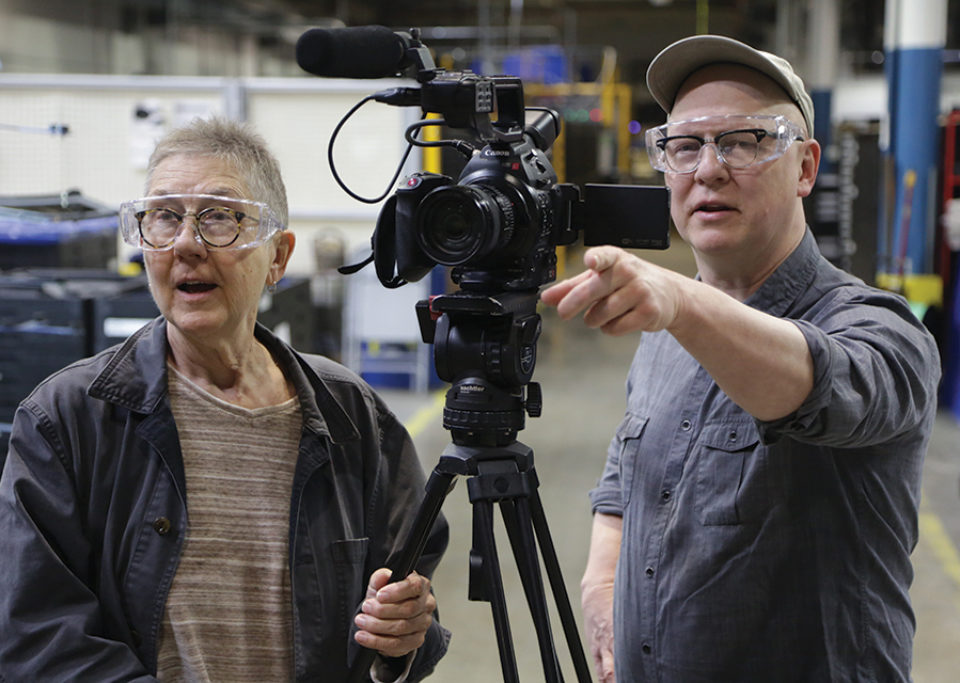By Eric Hynes in the September-October 2019 Issue

Make It Real: Double Shifts
With American Factory, Julia Reichert caps four decades of clocking in with labor by adding the view from the top
If that machine breaks down, there’s someone out there to fix it right away. If I break down, I’m just pushed over to the other side till another man takes my place. The only thing they have on their mind is to keep that line running.”
—Factory worker Phil Stallings, speaking to Studs Terkel, Working (1974)

From the September-October 2019 Issue
Also in this issue
Few places are as simultaneously profane and sacred, dignified and degrading, empowering and subjugating as the factory floor. There can be an intimacy, physical and otherwise, among workers, coterminous with alienation between workers and supervisors, blue and white collars. Some recent films have documented the contentious and seemingly futile state of affairs inside today’s factories, such as Machines (Rahul Jain, 2016), Of Rolls and Men (Charlotte Pouch, 2017), and Blow It to Bits (Lech Kowalski, 2019), which premiered at this past Cannes in the Directors’ Fortnight. Nikolaus Geyrhalter’s Over the Years (2015) might be the most attentive of these, witnessing the closing of an Austrian factory and then following up with select workers over the next decade, some of whom upend our expectations of what their post-factory lives would be like. That most adjust, and survive, doesn’t actually diminish their struggles, or disserve the film; lives, even righteous ones, rarely satisfy a theme.
With their most recent film, American Factory, Julia Reichert and Steven Bognar apply a kaleidoscopic lens to the embattled terrain of the modern factory floor. Winner of Best Director (U.S. Documentary) at the 2019 Sundance Film Festival and released in theaters and streaming on Netflix in August, American Factory is an omnivorous account of the opening of the Chinese-owned Fuyao car windshield plant in Dayton, Ohio. It’s in the same building that the directors watched shutter 10 years prior with their Academy Award–
nominated The Last Truck: Closing of a G.M. Plant (2009), and there are some familiar faces among those reemployed (though hired at a fraction of what they’d been paid by G.M.). But this time the Dayton-based rank and file are joined by Chinese laborers, Chinese and American supervisors, and a formidable Chinese executive, Chairman Cao Dewang. Unfamiliar with American labor practices, the Chairman nevertheless expects the fledgling plant to turn a profit within a year, and lets Reichert and Bognar roam throughout the factory to watch it happen. Four years later, they were still watching.
Soon after Studs Terkel published his monumental oral history of more than 100 wage-earning people in the United States, Working, Reichert co-directed her own vital and enduring oral historical document, Union Maids (1976, with Jim Klein and Miles Mogulescu), which was also her first film specifically about the American workforce. The labor-respectful, union-proud cultural moment that helped draw attention to both Terkel and Reichert’s work, as well as other pre-Reagan touchstones like Harlan County, U.S.A. and Norma Rae, has long since expired, with the post-election, pre-inauguration hit 9 to 5 (1980) serving as a swan song.
The conditions of American workers and the fate of unions have been worse off for such cultural neglect. But Reichert’s commitment has never abated. The struggles of working people—and working-class people—have remained central to her work, from that portrait of female union organizers (also nominated for an Oscar) up through American Factory. Her latest film is both an apex of her practice as well as a departure, attempting to craft a fair, balanced, and dexterous narrative of the entire ecosystem of the factory without forsaking the filmmakers’ underlying values or ultimate loyalties.

Julia Reichert and Steven Bognar. Photo by David Holm. Courtesy of Netflix.
“Our hearts are with the blue-collar workers,” Reichert told me during conversations begun at the Full Frame Documentary Festival in April and continued into the summer. (Durham-based Full Frame presented the first of numerous 2019 retrospectives of Reichert’s work, including ensuing stops at Hot Docs in Toronto, MoMA in New York, and the Wexner Center for the Arts in the director’s home state of Ohio.) Yet she and Bognar discovered that the problems confronted by the Chinese workers and administrators proved similarly compelling, and inextricable from the struggles of the American laborers. With Chinese workers accustomed to longer hours, riskier conditions, and less free time, their American counterparts are forced to either adapt or resist. Or face unemployment again.
“There was a new challenge to American Factory—accepting the challenge of a much more complicated situation,” Reichert said. “Some of the folks we got friendly with, and got to like, were people that in my younger years I would have considered my enemy. I would have had a more simplistic view of it. But having done all of this before, I really wanted to get inside of the management, instead of, you know, being on the barricades.”
How do you honor so many different and differing points of view without alienating any of them? Bognar likened the challenge to keeping four tops spinning simultaneously, which pays off in the edit but was a bear to pull off in the moment, and over time. It’s a film so evidently expansive and ambitious—the crew also journeys to China, acquiring even more characters along the way—that it can be easy to overlook how minutely calibrated it all is (owing no small debt to ace editor Lindsay Utz). Chairman Cao granted access and never revoked it, and also proved to be an astonishingly frank interview subject. “He could see that we weren’t a typical crew coming in to ask a few questions and leave,” Reichert said. “We were really there.”
Yet access could also raise suspicions. “The blue-collar people didn’t so much as care if the Chairman said it was okay for us to film. They were worried about being fired. Or ratted on by us,” Reichert said. Indeed, spending so much time with so many different factions meant being privy to information that other factions weren’t, challenging the voluble filmmakers to remain extra vigilant about not affecting the course of events. “We were carrying heavy tripods, heavy bags, and it’s hard to walk with a honkingly big camera bag for literally three miles in the course of the day. So we’d get rides on golf carts with one of the facility’s operation people, who are management,” Bognar recalled. “After a while we started to realize we’re passing these workers, and they see us . . . on a golf cart. And we’d look like management. So it got to the point where even though it’s 95 degrees [in the factory], we gotta carry these bags and tripods on foot.” The directors told stories of checking in with each department to establish connections that would endure and extend beyond the factory walls, and conducting interviews at work, at home, and everywhere in-between. (In addition to the directors, DPs included the film’s producer Jeff Reichert, Erick Stoll, and Aubrey Keith.)
When some workers sought to unionize and faced fierce opposition from Fuyao, tensions and paranoia spiked, putting the filmmakers in an increasingly tenuous position. “White-collar people would sometimes ask us: you’re pro-union, right?” Reichert said. “And the blue-collar people who were pro-union were afraid that we were somehow spies for management. And you can understand that. We had to find new ways to say we were neutral.”
What that effort yields in the end isn’t the readily emotive, union-advocacy elegy of The Last Truck, but something far knottier, something far harder to square. New jobs have come to Dayton. The plant is up and running again. But conditions are harsh, wages are low, and there’s no union looking out for workers’ rights—just Fuyao doing what’s best for Fuyao. Meanwhile Chinese workers try to adjust to living in Ohio, which is a world away from everything they know.
American Factory chooses a frame large enough to honor all of these elements, arguments, and experiences—a frame fitted to the dimensions of the factory where they all come together. That it’s also a synecdoche for Dayton, and for many Midwestern American towns, and for the state of global industry today, is undeniable and intentional, yet it’s not what the camera shows. The camera shows these people, in this place, doing their jobs, captured and mirrored by a team of other people doing theirs. Everyone’s making something, and it’s essential that we all consider how, and why, and what it means to them, and at what cost.
Eric Hynes is a journalist and critic, and curator of film at Museum of the Moving Image in New York.







